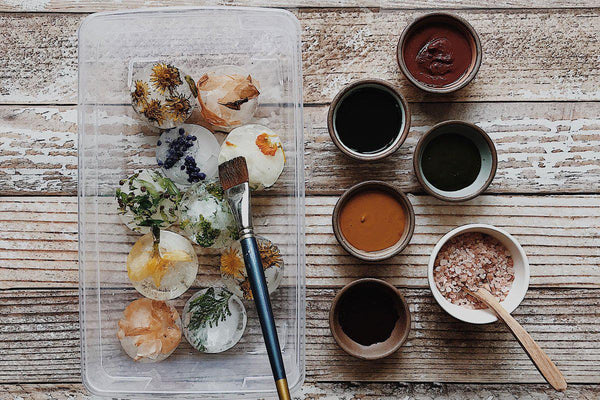
DIY | Conscious Crafts | Round two
We are back again this week with Julia from @simply.living.well with some more ideas on how to craft consciously with (or without!) your little one, just in time for a weekend craft session. Enjoy!

A fun way to use your homemade, plant-based paints is by painting ice blocks. Every spring and summer, I freeze ice by pouring water in cupcake, cake, pie, or baking trays and placing them in the freezer for a few hours to solidify. Then I place the ice blocks in a large plastic storage container (or an enamel basin), along with paints and other natural materials to explore with. Sometimes I mix it up a bit by freezing nature findings in the ice cubes, but that’s certainly not necessary.

Directions
1. Collect bits and bobs from nature – flowers, leaves, stones, etc.
2. Place nature bits in the bottom of your pie, cake, cupcake, or baking trays. Cover with water and place in the freezer for a few hours, or however long it takes for the water to turn to ice.
3. Once frozen, remove the trays from the freezer and pop the ice cubes out into the plastic storage container. If they don’t pop out on their own, you can run a little hot water on the underside of the metal tray until the ice melts just enough to pop out of the tray.
4. Paint away! Some children love the feeling of painting a smooth surface, but to mix things up a bit, you can give them a bowl of ice and let them sprinkle it onto the ice. It will stick to the ice and create an interesting (grainy!) medium for painting.
5. At the end of the project, once the ice melts, clean up is simple and sustainable - since all materials are natural, you can toss them in the compost bin!
 If you’re not familiar with God’s eyes, they’re an age-old craft beloved by children the world over. While they’re believed to have originated in Mexico where they’re referred to as Ojo de Dios, they can also be found among Native American and African cultures. You can almost always find wooden sticks in your backyard and, if you’re a crafter or maker, you probably have scraps of yarn piling up on the bottom of your knitting basket. I also love that this craft is fun and appropriate for kids of all ages. With little ones, you may need to help with the first couple of steps, but once the sticks are secure and the weaving is has been started, even the littlest of hands can take over and enjoy the process!
If you’re not familiar with God’s eyes, they’re an age-old craft beloved by children the world over. While they’re believed to have originated in Mexico where they’re referred to as Ojo de Dios, they can also be found among Native American and African cultures. You can almost always find wooden sticks in your backyard and, if you’re a crafter or maker, you probably have scraps of yarn piling up on the bottom of your knitting basket. I also love that this craft is fun and appropriate for kids of all ages. With little ones, you may need to help with the first couple of steps, but once the sticks are secure and the weaving is has been started, even the littlest of hands can take over and enjoy the process!
Directions
1. Cross the two sticks at their centres to form an “X”.
2. Secure the sticks together by wrapping a piece of yarn diagonally around the intersecting points 5-6 times. Rotate the sticks and wrap the yarn in the opposite direction, diagonally, 5-6 times.
3. Once the sticks are secure, wrap the yarn around one stick, one full rotation – going under the stick and back to the top. Extend the yarn to the next stick and wrap it around that stick the same way you wrapped it around the previous stick. It doesn’t matter which direction you wrap the yarn around the stick but you’ll want to be consistent throughout the process.
4. Continue wrapping and winding the yarn around the sticks, rotating the God’s eye as you work.
5. As you go, you may need to push the yarn towards the centre of the God’s eye, to create neat, even rows of yarn.
6. If you run out of yarn and want to add a new colour, simply cut the yarn you’re currently using and tie it to a new colour of yarn. Trim any excess yarn and continue weaving. As you’re weaving, do your best to keep the knot and tails towards the back of the ornament.
7. When you get to the ends of your sticks – with the yarn about an inch or so from the tips – stop weaving and wrap your yarn around one last stick. Tie a knot around the stick and cut the yarn, leaving a long tail that you can use to hang the God’s eye like an ornament.

 Welcome to Olli Ella!
Welcome to Olli Ella!













 If you’re not familiar with God’s eyes, they’re an age-old craft beloved by children the world over. While they’re believed to have originated in Mexico where they’re referred to as Ojo de Dios, they can also be found among Native American and African cultures. You can almost always find wooden sticks in your backyard and, if you’re a crafter or maker, you probably have scraps of yarn piling up on the bottom of your knitting basket. I also love that this craft is fun and appropriate for kids of all ages. With little ones, you may need to help with the first couple of steps, but once the sticks are secure and the weaving is has been started, even the littlest of hands can take over and enjoy the process!
If you’re not familiar with God’s eyes, they’re an age-old craft beloved by children the world over. While they’re believed to have originated in Mexico where they’re referred to as Ojo de Dios, they can also be found among Native American and African cultures. You can almost always find wooden sticks in your backyard and, if you’re a crafter or maker, you probably have scraps of yarn piling up on the bottom of your knitting basket. I also love that this craft is fun and appropriate for kids of all ages. With little ones, you may need to help with the first couple of steps, but once the sticks are secure and the weaving is has been started, even the littlest of hands can take over and enjoy the process!



